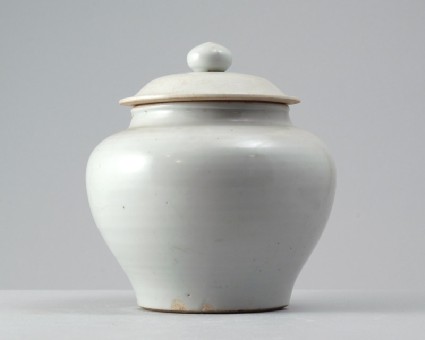The Barlow Collection
A select catalogue of the Barlow collection of Chinese Ceramics, Bronzes and Jades by the University of Sussex (published Sussex, 2006).

Publications online: 456 objects
White ware baluster jar and lid
- loan
-
Literature notes
Fragmentary white porcelain jars and covers of related form but much larger size have been excavated from the Xuande (1426–1435) stratum of the waste heaps of the Ming imperial kilns at Jingdezhen.
The jar is of baluster form, with wide bulging shoulder tapering in a curve towards the flat base which has a chamfered edge. The short, splayed neck has an emphasized rim flange, which holds a domed cover with everted, slightly upturned rim and onion-shaped knob. The jar shows turning marks around the sides. Both parts are covered with a smooth milky-white glaze with a distinct blue tinge on the inside of the jar, but neutral on the outside. The base and underside of the cover are unglazed, showing the white body. The cover is inscribed underneath in black ink wen wei nan lou (‘suitable for the southern pavilion’). -
Details
- Associated place
-
Asia › China › Jiangxi province › Jingdezhen › Jingdezhen kilns (place of creation)
- Date
-
15th century (1401 - 1500)
Ming Dynasty (1368 - 1644)
- Material and technique
- porcelain, thrown, with white glaze; lid, with black ink inscription
- Dimensions
-
17.4 cm (height)
16.1 cm (diameter)
at base 9.8 cm (diameter)
- Material index
- Technique index
- Object type index
- No. of items
- 2
- Credit line
- Lent by the Sir Alan Barlow Collection Trust.
- Accession no.
- LI1301.52
-
Further reading
University of Sussex, and Arts and Humanities Research Council, The Barlow Collection, supervised by Regina Krahl, Maurice Howard, and Aiden Leeves (Sussex: University of Sussex, 2006), no. C17
Glossary (2)
glaze, porcelain
-
glaze
Vitreous coating applied to the surface of a ceramic to make it impermeable or for decorative effect.
-
porcelain
Ceramic material composed of kaolin, quartz, and feldspar which is fired to a temperature of c.1350-1400⁰c. The resulting ceramic is vitreous, translucent, and white in colour.
Location
-
- currently in research collection
Objects are sometimes moved to a different location. Our object location data is usually updated on a monthly basis. Contact the Jameel Study Centre if you are planning to visit the museum to see a particular object on display, or would like to arrange an appointment to see an object in our reserve collections.
Publications online
-

The Barlow Collection
Fragmentary white porcelain jars and covers of related form but much larger size have been excavated from the Xuande (1426–1435) stratum of the waste heaps of the Ming imperial kilns at Jingdezhen.
The jar is of baluster form, with wide bulging shoulder tapering in a curve towards the flat base which has a chamfered edge. The short, splayed neck has an emphasized rim flange, which holds a domed cover with everted, slightly upturned rim and onion-shaped knob. The jar shows turning marks around the sides. Both parts are covered with a smooth milky-white glaze with a distinct blue tinge on the inside of the jar, but neutral on the outside. The base and underside of the cover are unglazed, showing the white body. The cover is inscribed underneath in black ink wen wei nan lou (‘suitable for the southern pavilion’).
Notice
Object information may not accurately reflect the actual contents of the original publication, since our online objects contain current information held in our collections database. Click on 'buy this publication' to purchase printed versions of our online publications, where available, or contact the Jameel Study Centre to arrange access to books on our collections that are now out of print.
© 2013 University of Oxford - Ashmolean Museum




